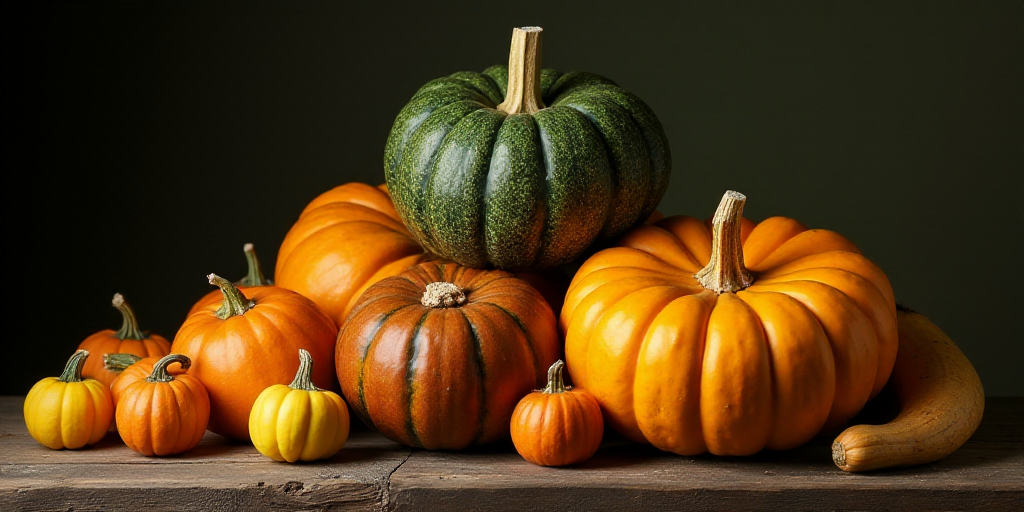Introduction
Mexico is the heartland of the Cucurbita genus, home to a rich variety that spans from field to altar and from sweet dishes to soups. This fall, we celebrate the diversity of Mexican pumpkins.
Historical Significance
Long before corn and beans, pumpkins were already part of the Mesoamerican diet. Archaeological evidence shows that the “calabacita” and “pipiana” were domesticated over 8,000 years ago, becoming one of the earliest cultivated crops on the continent. Since then, this fruit has become intertwined with Mexico’s history, mythology, and gastronomy.
The Cucurbita Genus
Exclusively American, the Cucurbita genus comprises 15 species with around 20 subspecies. Most of these grow and are cultivated in Mexico. In Nahuatl, it’s called “ayotli”; in Mayan, “dzot” or “k’uum”; and in Zapoteco, “güicha.” Each name evokes a root, a land, and a way of understanding abundance.
Pumpkins in the Milpa System
In Mexico, pumpkins accompany corn and beans in the milpa agricultural system, where they play vital roles: protecting the soil, providing shade, and completing the diet.
Notable Pumpkin Species
Castilla or Güicha Pumpkin (Cucurbita pepo)
This is the most common and holds the greatest commercial importance in the country. It adapts from the Yucatan Peninsula to central highlands, displaying a remarkable variety of shapes, sizes, and colors. Every part is utilized: flowers in quesadillas or creams, tender fruits in stews, stems as quelites, and seeds as a base for pipián.
Pipiana or Tecomata Pumpkin (Cucurbita argyrosperma)
Typical of warm climates, it’s distinguished by its thick stalk and large seeds with bluish edges. Highly valued in Mexican cuisine for its flavor and nutritional contribution, its domestication is attributed to Oaxaca, where communities have selected varieties for centuries.
Casco or Pellejo Pumpkin (Cucurbita moschata)
Growing in tropical, humid regions, it’s one of the sweetest and most aromatic. Its orange flesh, rich in carotenoids, transforms into pumpkin in tacha, atoles, and seasonal sweets. Some varieties with thick shells are also used as natural containers or for decoration.
Chilacayote (Cucurbita ficifolia)
Adapted to temperate zones, it produces large fruits with black or white seeds. Popular in Oaxaca’s Central Valleys, it’s prepared in crystallized sweets or fresh water. Its origin remains uncertain, though it’s believed to have been domesticated in the Andean region.
Zapallo or Kabosha (Cucurbita maxima)
Originating from South America, this pumpkin type is primarily cultivated in Sinaloa and Sonora, where it has found an ideal environment for growth. With a soft texture and delicate flavor, it’s increasingly integrated into the gastronomy of northern Mexico.
Wild Pumpkins: The Hidden Treasure
Mexico also hosts 11 wild pumpkin species, five of which are endemic. Though not edible due to their bitter taste (caused by cucurbitacins), they are crucial for biodiversity and the future of agriculture.
Xerophile species like C. palmata or C. foetidissima live in arid regions and store water in their roots. Mesophile species like C. fraterna and C. sororia prefer moist environments. In rural communities, some are used as natural soap or medicinal remedies due to their saponins.
The CONABIO promotes the “Diversity Genetic of Cucurbita Species in Mexico” project, studying their genomes and aiming to conserve the ancestral heritage of these plants.
From Field to Altar
In autumn, pumpkins mature alongside Día de Muertos celebrations. Their orange color blends with marigold flowers, and their sweet aroma signals the season’s arrival. In Mexican kitchens, pumpkin pieces simmer with piloncillo and cinnamon while seeds are toasted for mole or pipián.
Beyond the plate, pumpkins symbolize abundance and fertile land. In a country that uses every part—flowers, stems, seeds, pulp—pumpkins remain a living metaphor for Mexican cuisine: generous, diverse, and deeply connected to nature.
Key Pumpkin Species in Mexico
- Castilla or Güicha Pumpkin (Cucurbita pepo): Common, adaptable, and versatile in culinary uses.
- Pipiana or Tecomata Pumpkin (Cucurbita argyrosperma): Warm-climate specialist, prized for flavor and nutrition.
- Casco or Pellejo Pumpkin (Cucurbita moschata): Sweet and aromatic, used in various sweet dishes.
- Chilacayote (Cucurbita ficifolia): Temperate-zone pumpkin, popular in Oaxaca’s Central Valleys.
- Zapallo or Kabosha (Cucurbita maxima): Originating from South America, increasingly integrated into northern Mexican cuisine.
Wild Pumpkin Species in Mexico
Mexico hosts 11 wild pumpkin species, five of which are endemic. Though not edible, they contribute to biodiversity and agricultural conservation efforts.






